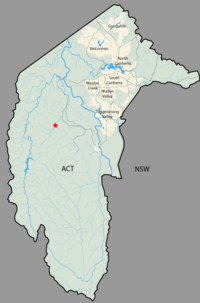This is an old revision of this page, as edited by N2e (talk | contribs) at 04:53, 14 July 2015 (cn). The present address (URL) is a permanent link to this revision, which may differ significantly from the current revision.
Revision as of 04:53, 14 July 2015 by N2e (talk | contribs) (cn)(diff) ← Previous revision | Latest revision (diff) | Newer revision → (diff)Observatory
 Canberra Deep Space Communication Complex (CDSCC) Canberra Deep Space Communication Complex (CDSCC) | |
| Alternative names | CDSCC |
|---|---|
| Organization | CSIRO / NASA / JPL |
| Location | Tidbinbilla, Australian Capital Territory |
| Coordinates | 35°24′05″S 148°58′54″E / 35.40139°S 148.98167°E / -35.40139; 148.98167 |
| Altitude | 550 m |
| Established | March 19, 1965 |
| Website | www.cdscc.nasa.gov |
| Telescopes | |
| Telescopes | |
 | |
| | |
| [edit on Wikidata] | |

The Canberra Deep Space Communication Complex (CDSCC) is a ground station that is located in Australia at Tidbinbilla in the Paddys River (a tributory of the Cotter River) valley, about 20 km from Canberra in the Australian Capital Territory. The complex is part of the Deep Space Network run by NASA's Jet Propulsion Laboratory (JPL). It is commonly referred to as the Tidbinbilla Deep Space Tracking Station and was officially opened on 19 March 1965 by the then Prime Minister of Australia Sir Robert Menzies.
The station is separated from Canberra by the Murrumbidgee River, but most notably by the Coolamon Ridge and Urambi Hills, but mainly by Bullen Range, that help shield the city's radio frequency (RF) noise from the dishes. Located nearby is the Tidbinbilla Nature Reserve.
The CSIRO manages most of NASA's activities in Australia.
In February 2010 CSIRO took over direct management of the site with the establishment of CASS (CSIRO Astronomy and Space Science). Previous to this CDSCC had been managed by external sub-contractor organisations, such as Raytheon Australia from 2003-2010.
The complex is one of three in the world. The other two are the Madrid Deep Space Communication Complex located in Spain, and the Goldstone Deep Space Communications Complex in California, USA.
History

During the mid 1960s NASA built three tracking stations in the Australian Capital Territory.
- The Tidbinbilla Tracking Station (now known as CDSCC) was opened in 1965 and is the only NASA tracking station in Australia still in operation. During the Apollo program, Tidbinbilla was used for tracking the Apollo Lunar Module.
- The Orroral Valley Tracking Station (35°37′43″S 148°57′20.8″E / 35.62861°S 148.955778°E / -35.62861; 148.955778) was opened in May 1965 in what is now part of Namadgi National Park. Its role was orbiting satellite support, although it also supported the Apollo-Soyuz Test Project in 1975. It was closed in 1985.
- Honeysuckle Creek Tracking Station (35°35′1″S 148°58′36″E / 35.58361°S 148.97667°E / -35.58361; 148.97667 (Honeysuckle Creek)) opened in 1967 and was built primarily to support the Apollo moon missions, mainly communications with the Apollo Command Module. After the cancellation of the Apollo Project the station supported Skylab until its re-entry in 1979 when the station joined the Deep Space Network in support of the Viking and Voyager projects. 1981 saw the closure of the station and its 26 m antenna was moved to CDSCC to become known as Deep Space Station 46. After the antenna was removed the rest of the facility was dismantled and knocked down. Its foundation, access road and parking area are all that remains of the facility
Receivers
As of late 2014 the Station has four large antennas in use: DSS-34, DSS-35, DSS-43, and DSS-45. The CDSCC also uses the Parkes radio telescope in central New South Wales at busy times to receive data from spacecraft. There is ongoing construction to build an additional 34 m beam waveguide antenna by 2017. Construction of DSS-35 began in July 2010. The station's collimation tower is located approximately 3 km to the north-west, on Black Hill.
| Photo | Name | Diameter | Notes |
|---|---|---|---|
| DSS-34 | 34 m | Beam waveguide antenna, uses a system of radio frequency mirrors to place the receiving and transmitting hardware underground rather than on top of the dish. It is the most recent antenna at CDSCC, being built in 1997. | |
 |
DSS-43 | 70 m | Originally constructed as a 64 m dish in 1973 and enlarged in 1987. It is the largest steerable parabolic antenna in the Southern Hemisphere. The antenna weighs more than 3000 tonnes and rotates on a film of oil approximately 0.17mm thick. The reflector surface is made up of 1,272 aluminium panels with a total surface area of 4180 square metres. |
| DSS-45 | 34 m | Built in 1986. | |
 |
DSS-46 | 26 m | It was moved in 1984 from Honeysuckle Creek, where it was built in 1967. It was decommissioned in late 2009. In May 2010 the AIAA (American Institute of Aeronautics and Astronautics) declared the antenna a Historical Aerospace Site. |
 |
DSS-49 | 64 m | Parkes radio telescope |
 |
DSS-35 | 34 m | Operational in late 2014 and officially opened in March 2015. |
 |
DSS-36 | 34 m | Expected to be operational in the 2016-2017 timeframe. |
See also
References
- "Antenna Construction - page 8" (PDF). NASA. Retrieved 18 July 2010.
- "AustraliaHistoricalSite" (PDF). AIAA. Retrieved 18 July 2010.
External links
- Partners in space: CSIRO and NASA - video
- Official CDSCC Webpage
- Official CSIRO pages
- Tidbinbilla Tracking Station tribute site
- Honeysuckle Creek tribute site
| NASA facilities | |||||
|---|---|---|---|---|---|
| NASA Headquarters | |||||
| Primary 10 centers |
| ||||
| Other facilities |
| ||||
| Related | |||||
Categories: